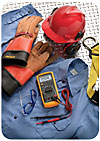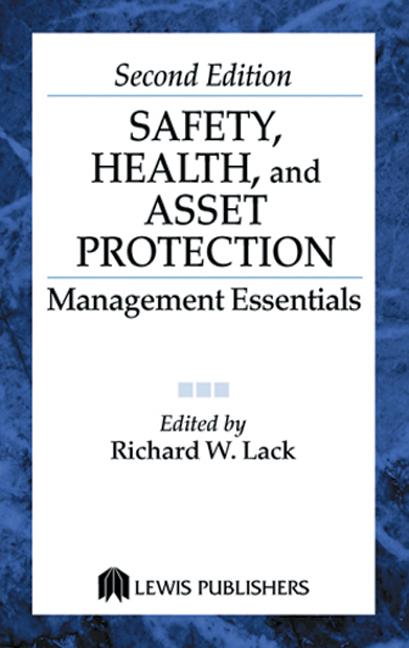
Any work near live electrical circuits poses its share of risk, and electrical measurement jobs are no exception. In commercial and industrial settings today, electricians commonly work with circuits up to 600 V. Though officially classed as “low voltage,” these powerful circuits can deliver a deadly punch.
In addition to the danger of electrical shock, such circuits have enough power available to fuel an electric arc explosion, which can generate the searing heat called arc flash and the noise and pressure wave caused by arc blast. When arc flash occurs, having the right personal protective equipment (PPE) can protect the electrician from horrific injury, pain, and even death.
Danger — voltage transients
Voltage kickback spikes, called transients, create important safety implications. When transients occur while a person is taking electrical measurements, they can lead to an arc explosion.
Transients are present in almost every electrical installation. In industrial settings they may be caused by the switching of inductive loads and by lightning strikes. Though such transients may last only sub-milliseconds, if they cause an arc flash, that installation could suddenly carry tens of thousands of amps of energy. For anyone taking measurements on electrical equipment, the consequences can be devastating.
When such spikes occur while measurements are being made, they can cause a plasma arc to form — inside the measurement tool or in the air outside. The high fault current available in 480 V and 600 V systems can generate an extremely hazardous arc flash.
Understanding arc flash
How can such a problem develop? A transient of sufficient magnitude can cause an arc to form between conductors within an instrument, or across test leads. Once an arc occurs, the total available fault current can feed the arc and cause an explosion.
The result is an arc flash, which can cause a plasma fireball fueled by the energy in the electrical system. Temperatures can reach about 3,000°C, or 5,000°F, instantly burning or melting any non-retardant clothing and causing beyond third-degree burns. The arc can also cause a sonic and pressure wave capable of spraying a bystander with molten metal, inducing further, deeper burns.
Transients are not the only source of arc-flash hazard. A very common misuse of handheld multimeters can trigger a similar chain of events. If the multimeter user leaves the test leads in the amps input terminals and connects the meter leads across a voltage source, that user has just created a short through the meter. While the voltage terminals have a high impedance, the amps terminals have a very low impedance. This is why a meter’s amps circuit must be protected with fuses.
Another dangerous misuse of test equipment is measuring ohms or continuity on a live circuit. Make these measurements only on circuits that are not energized.
The National Fire Protection Association (NFPA) 70E Standard for Electrical Safety in the Workplace 2004 emphasizes that working on live parts is the last alternative. According to OSHA, equipment must be de-energized unless the employer can demonstrate that de-energizing introduces additional or increased hazards or is infeasible due to equipment design or operational limitations. When working on live equipment is necessary, protecting yourself with the proper gear is vital.
Know your electrical environment
Standards organizations such as the American National Standards Institute (ANSI) and American Society for Testing and Materials (ASTM) have developed detailed requirements and specifications for such protective equipment as eye and hearing protection, insulated hand tools, insulated gloves and fire-resistant clothing. NFPA standard 70E provides guidelines for when and where this approved safety equipment should be used. NEC (National Electrical Code) Article 110.16 further defines PPE.
Electrical test tools and equipment must also meet safety requirements. Organizations such as ANSI, the Canadian Standards Association (CSA) and the International Electro-Technical Commission (IEC) establish standards for these tools. Four measurement categories cover over-voltage transient impulses. The rule of thumb is that the closer the technician is working to the power source, the greater the danger and the higher the measurement category number. Lower category installations usually have greater impedance, which dampens transients and helps limit the fault current that can feed an arc.
When making a live electrical measurement, start by determining which of the CAT levels below applies and then verify that all of your test and measurement equipment is rated for that level.
- CAT IV is associated with the origin of installation. This refers to power lines at the utility connection, but also includes any overhead and underground outside cable runs, since both may be affected by lightning.
- CAT III covers distribution level wiring. This includes 480 V and 600 V circuits such as 3-phase bus and feeder circuits, motor control centers, load centers and distribution panels. Permanently installed loads are also classed as CAT III. CAT III includes large loads that can generate their own transients.
- CAT II covers the receptacle circuit level and plug-in loads.
- CAT I refers to protected electronic circuits.
NFPA 70E includes a formula to calculate the arc-flash energy available and determine a “flash protection boundary” (calculations that must be performed by a professional engineer). Within that boundary, flash protective PPE is required, and 70E includes tables that specify what gear is required to protect workers in various hazard/risk categories. A summary of that information for live electrical measurement situations is provided in Figure 1. In all cases, PPE selection depends on the work being performed and the electrical environment.
In the final analysis, you must protect workers from the extremely hazardous conditions of arc flash and arc blast. Evaluate your environment, wear your PPE and select your electrical test tools carefully.
SIDEBAR: Hazard/Risk Categories
Hazard/Risk Category 1:<240 V electrical environments (110 V/120 V/208 V/220 V panels, 0-50 hsp motors and drives):• Flame-resistant (FR) long-sleeved shirt and/or jacket with sleeves rolled down and front fully buttoned up (FR clothing must fully cover all skin and ignitable clothing);
• Natural fiber work pants;
• Rubber insulating gloves with leather protectors worn over top;
• Safety glasses;
• Hard hat;
• Leather work boots;
• No jewelry, keys or watch;
• Insulated hand tools.
Hazard/Risk Category 2*:240 V to 600 V electrical environments (270/480/600 V electrical panels, MCCs, switchgear, transformers, bus bars, UPS, and lighting; 100+ hsp motors and drives):
• FR long-sleeved shirt and/or jacket with sleeves rolled down and front fully buttoned up;
• FR work pants (not denims) or coveralls over natural fiber;
• Rubber insulating gloves with leather protectors worn over top;
• Leather work boots;
• Switching hood with hearing protection;
• No jewelry, keys or watch;
• Insulated hand tools.
Hazard/Risk Category 3: High voltage environments (1600 A or higher) (Substations, utility transformers, big facility service entrances):
• Full flash suit (jacket, overalls and hood);
• Rubber insulating gloves with leather protectors worn over top;
• Leather work boots;
• No jewelry, keys or watch;
• Insulated hand tools.
(Note: If test occurs in the proximity (within 4 feet) of an energized environment, then the PPE standards for the energized environment apply.)
(Note: Category 2* is a higher energy environment than Category 2. These guidelines only list PPE for Category 2*. For the specific distinction between 2 and 2*, reference NFPA Standard 70E Tables 130.7 (c)(9)(a), (c)(10), (c)(11).)
Make a note:CAT ratings on test tools are different than hazard/risk category ratings on PPE gear. CAT ratings are determined by the potential transient impulse in the workplace that a connected test tool might experience. PPE requirements are determined by the surface energy level a user might experience.




